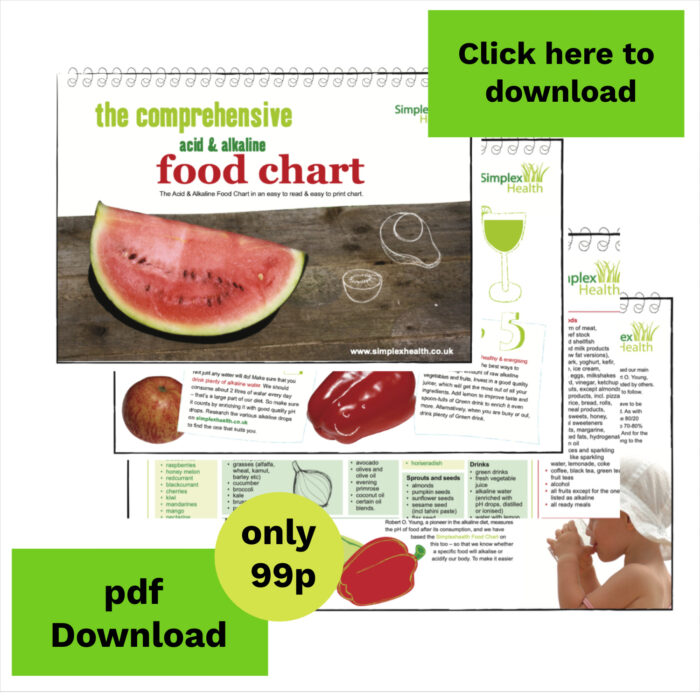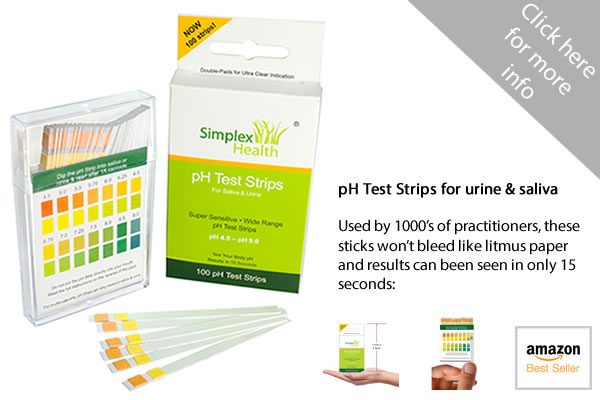Acidic and Alkaline Foods: Check if your diet contains sufficient alkaline food groups
According to the Alkaline Diet, it is important for our health and well-being that we maintain an optimum pH balance within our body and hence avoid acidosis:
‘The body functions at its best when the pH of its internal bio-chemical environment, measured as a whole, is equal to 7.39, meaning slightly alkaline. …illness will accompany any incidence of acidosis or alkalosis. …acidosis is by far the most common… because both modern lifestyle and diet promote acidification of the body’s internal environment.’
Christopher Vasey, Expert on the Alkaline Diet*
Why do so many people suffer from acidosis?
New methods of food production, changes in society and different lifestyles have contributed towards a change in how we prepare and consume our food and how we live. Some people even say that this has caused a health crisis in our society. After all it is no coincidence that certain illnesses like cancer and diabetes have increased at the same time as the standard diet contains more and more acidic elements like proteins, cereals, sugar and bad fats.
How can you achieve an acid-alkaline-balance or pH Balance?
This is not as difficult and complicated as it sounds. First of all, it is important to consume foods, which have an alkalising effect on the body. This effect depends on the mineral content of the food and the ash, which remains once the food has been processed within the body*. Some foods leave an acidic ash, whilst others leave an alkaline ash. Generally speaking, alkaline foods, are also the foods which we know are good for us. They include fresh vegetables and foods with low sugar content. Bad for us are the obvious: sweets, coffee, tea, alcohol, smoking, meat, fast food and many dairy products. Stress, nervous tension, noise and a lack of physical exercise also contribute to the body’s acidification.
Every body is different and reacts in differing ways to this change. Whilst some are more susceptible than others, we should all aim towards a healthy diet. Experts recommend, it should consist of 80% of alkaline food. Below we have provided one of the most comprehensive overviews of alkaline and acid foods to help you optimise your diet.
This does not need to be a complicated calculation, simply have a look at your plate: is 70-80% of it made up of alkaline foods? And does the remaining 20-30% of acid forming foods belong to the category of slightly or highly acidifying foods*? A pizza made with wholemeal flour is less acidic than one made with processed white flour, and tofu is less acidic whilst lentils are very acidic*. Fresh water wild fish is also much less acidic than farmed fish.
So choose your foods wisely, we would recommend oily fish, wholemeal products as well as wild rice for instance.
Becoming alkaline and preventing acidosis
Our alkaline food recommendations are mostly based on recommendations by Christopher Vasey*. He amongst other authors has written a lot about the alkaline diet. In some cases the experts contradict each other in their recommendations, for instance, some would recommend quark and tomatoes as alkaline foods, whilst others consider them to be acidifying. To make it easier for you to decide what to eat, we have based our main recommendations on the strictest authors, and then added the foods also recommended by other experts. That way you can decide which experts to follow.
pH Balance Diet – Alkaline fruits:
lemon, avocado, lime, tomato, grapefruit, coconut;
some experts also recommend: watermelon, apples, pineapple, apricot, bananas, pears, clementine, fresh dates, strawberries, figs, blueberries, raspberries, honey melon, redcurrant, blackcurrant, cherries, kiwi, mandarines, mango, nectarine, green and black olives, oranges, papaya, peach, plums, gooseberries.
pH Balance Diet – Alkaline vegetables:
asparagus, aubergines, cabbage (green cabbage, white cabbage, red cabbage, napa cabbage), onions, cauliflower (incl romanesco), radish, fresh peas, marrow, young spinach, carrots, green beans, beetroot, celery, peppers, sweet potato, grasses (alfalfa, wheat, kamut, barley etc), cucumber, broccoli, kale, brussels sprouts, pumpkin;
some experts also recommend: artichokes, mushrooms (incl shiitake), chicory, fennel, spring onions, potatoes, kohlrabi, leeks, turnip, mangold, parsnip, swede, okra, radicchio, algae (spirulina, chlorella, hijiki, wakame, nori).
Green drinks are a great source of vegetables and green grasses, as they contain a variety of different ingredients, providing an optimal blend and they can be prepared easily and quickly; which is important for busy people!
pH Balance Diet – Alkaline herbs and lettuce:
watercress, lamb’s lettuce, garlic, lettuce, chive, basil, green and red chillies, endive, coriander, dandelion, parsley, chard;
some experts also recommend: summer savory, nettle, iceberg lettuce, fennel seeds, garden cress, frisee, ginger, capers, cardamon, chervil, kurkuma (yellow ginger), lattich, lovage, cumin, borage, lollo rosso lettuce, lemon balm, nutmeg, majoran, horseradish, clove, oregano, pepper (black, green, white, red), peppermint, allspice, romaine lettuce, rosmary, ruccola (rocket) lettuce, safran, sage, sorrel, nigella sativa, thyme, vanilla, hyssop, cinnamon.
pH Balance Diet – Alkaline sprouts and seeds:
almonds, pumpkin seeds, sunflower seeds, sesame seeds (incl tahini paste), flax seeds, buckwheat groats, spelt, most sprouted seeds (including soya, alfalfa, mungo beans, chickpeas, broccoli), hummus, soy sprouts.
pH Balance Diet – Alkaline drinks:
green drinks, fresh vegetable juice, alkaline water (enriched with pH drops or liquid chlorophyll), water with lemon or lime juice, various herbal teas (our recommendation is rooibos tea), vegetable broth, unsweetened soya milk, almond milk, goats milk.
pH Balance Diet – Alkaline fats and oils:
flaxseed oil, hempseed oil, avocado, olives and olive oil, evening primrose, coconut oil, certain oil blends especially oil blends containing Omega 3-6-9.
Generally, it is recommended to eat loads of salads, fresh alkaline vegetables as well as healthy sprouts and nuts. Most of the fresh foods should be consumed raw (as cooking may reduce the nutrient content) together with 2-3 litres of water. In most areas, tap water is mildly acidic, with traces of chlorine, heavy metals and other nasties. Test your tap water before using it for daily consumption. Enrich your water with pH drops to create alkaline, mineral-rich water. Typical acid-forming foods are alcohol, smoking, fast food and ready-made foods, sugary foods and anything made with white flour.
Acid foods
Acid foods should make up the smallest part within the diet. Some foods like wholemeal products, have a lower acidifying effect, and could represent the 20-30% of acid foods in a daily diet.
- any form of meat, including beef stock
- fish and shellfish
- milk and milk products (incl low fat versions), like quark, yoghurt, kefir, cheese, ice cream, cream, eggs, milkshakes
- mustard, vinegar, ketchup
- most nuts, except almonds
- wheat products, incl. pizza, pasta, rice, bread, rolls, wholemeal products,
- sugar, sweets, honey, artificial sweeteners
- transfats, margarine, saturated fats, hydrogenated oil, corn oil
- fruit juices and sparkling drinks, like sparkling water, lemonade, coke
- coffee, black tea, green tea, fruit teas
- alcohol
- all fruits except for the ones listed above
- all ready meals
The general guidance is that fatty meats, dairy products, sweets, alcohol, tobacco are to be avoided. Fast food and ready meals often lack important nutrition and are full of sugar, salt and other hidden offenders.
How pH balanced is your body?
It is worth regularly testing your body for its pH with pH Test Strips. Water enhancers, like pH drops as well as green drinks are a great way of helping you to achieve an optimum acid-alkaline balance and hence achieve better performance and energy levels.
Daily implementation
First of all, look at the water you consume. Make sure it is alkaline and mineral-rich by using pH drops. Especially young sprouts of various grasses as well as raw vegetables can be useful to establish an alkaline environment within the body and can increase energy levels. These can be grown and harvested at home in specifically developed containers. Alternatively, alkaline experts have developed optimum blends of a various vegetables and young grasses (called Green Drinks), which can simply be mixed with water. To view our complete range of Alkalising Supplements, please click here.
* Christopher Vasey, The Acid-Alkaline Diet for Optimum Health, 1999
Further Information:
- Alkaline Diet Resources – Overview
- How to test the pH of your body using pH test strips
- Guide to alkaline minerals & salts – Click here
- Guide to pH drops – Click here for our guide to pH drops
- Guide to alkaline water – Click here to find out more
Disclaimer: These products are dietary supplements and are not intended to diagnose, treat or prevent any diseases. None of the statements above have been evaluated by the US food and drug administration. Only opinions based upon our own personal experience or information detailed in publications is cited. This has been done exclusively for anyone who is interested in this subject but is not intended to replace proper analysis. WE DO NOT OFFER MEDICAL ADVICE or prescribe any treatments. This refers to any form of conversation between SimplexHealth and our customers, readers or website visitors. We cannot accept responsibility and liability of any kind which may result from the application of this information. We always recommend consulting an expert to discuss any test results or get a full recommendation on the specific subject and specific to your situation by an expert.
This information is owned by SimplexHealth and you do NOT have the right to reprint, sell, auction or distribute this information.


